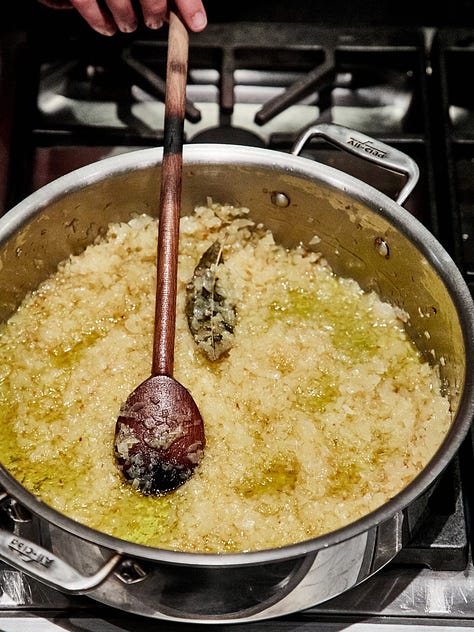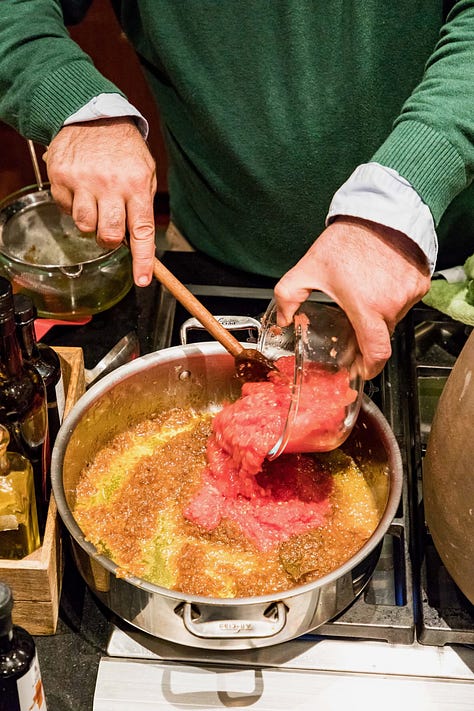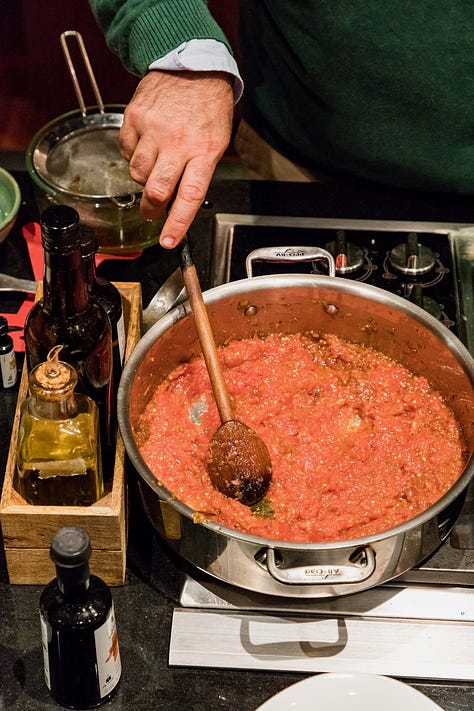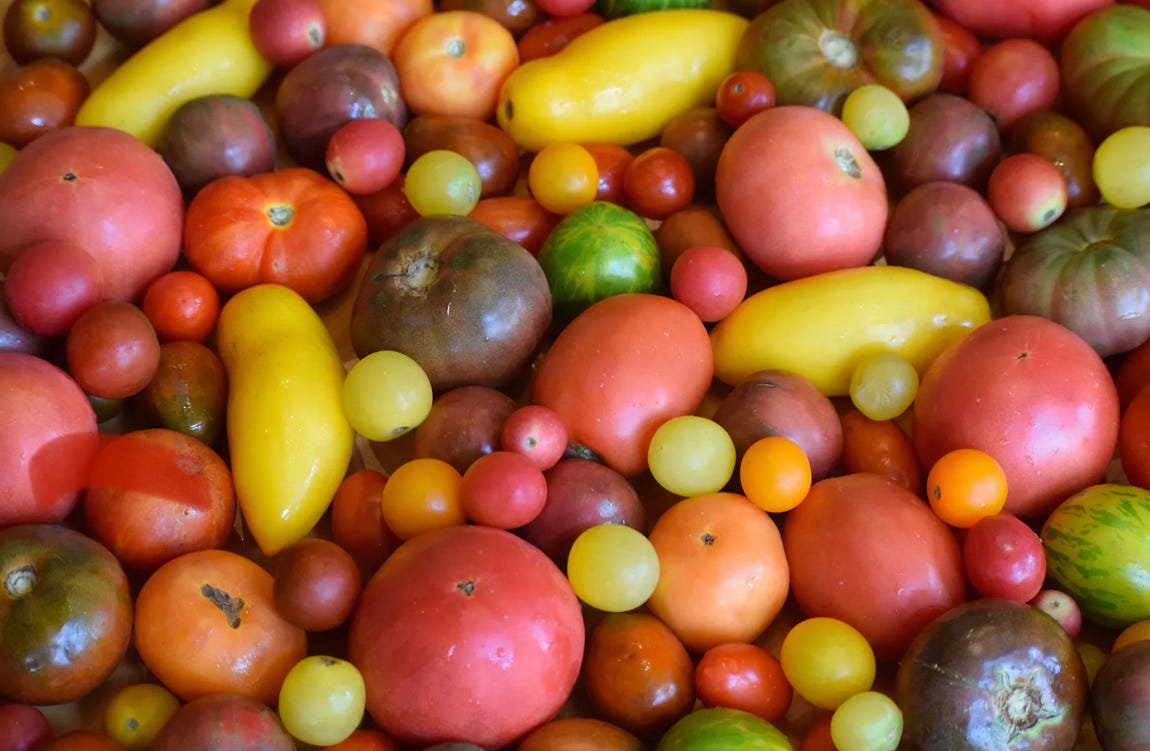Happy Monday, friends, I hope you all had a wonderful weekend. Did you see what our barmini team was up to last week?? They were at Tales of the Cocktail, an amazing cocktail conference where beverage professionals can learn lots of new things and exchange industry wisdom. Now I want a cocktail!
Today, I am sharing with you something that you should have in your culinary toolbox: sofrito! Sofrito is a base of aromatic ingredients that you cook to release their flavors and prepare for other dishes, like soups, stews, and of course some paellas and other rices. The word Sofrito means “lightly fried” in Spanish, which is what we do to the onions when you first start making the sauce. Once you’ve mastered sofrito, you realize you are doing yourself a HUGE favor, because it’s the foundation of so many amazing traditional Spanish dishes.
Lots of different culinary traditions have their own version of sofrito—my friend Eric Ripert might start his dishes with mirepoix, and of course Emeril would use the holy trinity. But, everything of course comes back to Spain! They were all inspired by the Llibre de Sent Soví, a Catalan cookbook from 1324. Originally, sofrito was just onions or leeks and a fat such as oil or pork lard, and when tomatoes came to Europe, they were incorporated into our sofritos.
When I worked many, many years ago at L’Antull, a restaurant in Roses, up the coast from Barcelona, I made a big batch of sofrito twice a week during the busy season as preparation for many other dishes. One of my first mentors, Ramon Closes, was an amazing boss, but if the sofrito wasn’t done the way he wanted, let’s just say pans would go flying! But he wasn’t wrong, because it sets up the base for so many things, so you want to take a lot of care when you’re making it.
The classic Catalan sofrito—called sofregit in Catalan—is made from tomatoes, onions, olive oil, bay leaves and pimentón. Other Spanish versions include garlic or peppers, and sometimes even carrots. Lots of Caribbean and Latin American food also feature sofritos…for example, many Puerto Rican sofritos include cilantro and annatto seeds, while in the Dominican Republic, they often use vinegar.
People—when you make a sofrito, you can’t forget about the most important ingredient…time! You can’t make sofrito in a hurry. The key to a good Spanish sofrito is cooking the onions until they are caramelized, which requires time, heat, and a LOT of patience. At the beginning the onions are sharp, but as the water in them evaporates, their fibers break down, and the sugars break down and transform pungent onion flavors into something sweet and amazing. It’s like taming a wild horse. You don’t do that with brute force, but with love—you convince them that you’re on their side!



This recipe is a classic version of Catalan sofrito, which is very concentrated. I recommend cooking the onions for about 45 minutes, but it’s even better if you let them go for a couple of hours. I find the act of making sofrito very therapeutic, a way to make the world slow down around me. To watch these simple ingredients transform into something is, for me, the ultimate expression of great cooking. But it’s also as good as the ingredients you put into it, so it is worth investing in good, quality olive oil. A great sofrito is one you can barely taste, but it’s the invisible hand that holds so many Spanish dishes together.
Catalan tomato and onion sofrito
Makes 3 cups
1 1/2 cups extra-virgin olive oil
2 large Spanish onions, finely chopped (about 4 cups)
Sugar, to taste
1 teaspoon kosher salt
10 ripe plum tomatoes
1 teaspoon sweet pimentón
3 bay leaves
Heat the oil in a medium saucepan over medium-low heat. Add the onions, sugar, and salt and cook, stirring occasionally, until the onions are soft and golden brown, about 45 minutes. You want the onions to caramelize, but if they start to get too dark, add 1/2 teaspoon or so of water to keep them from turning brown.
Meanwhile, slice the tomatoes in half. Grate the cut sides of the tomatoes on the large holes of a flat or box grater set over (or in) a bowl. Discard the skins.
Stir in the tomato puree, pimentón, and bay leaves into the onions and cook for another 20 minutes or so over medium heat. You’ll know the sofrito is ready when the tomatoes have broken down and deepened to an almost rust color and the oil has separated from the sauce. Remove from the heat and discard the bay leaves. The sofrito will keep covered in the refrigerator for 2 weeks, or you can scoop a cooled-off sofrito into an ice cube tray and freeze it. A single cube will add instant depth to soups, stews, and sautes of all stripes, Spanish or not.
Tell me…have you made a Spanish sofrito? How do you use it?




I have been making Jose’s Catalan Sofrito recipe for a very long time, and it never ceases to please. It does take patience and vigilance. Follow Chef Andres’ advice on adding the tiniest bit of water if there is some burnt onion, adding too much water starts to change the texture of the onions. I use this almost as a chutney / sauce with Chef’s pork meatball recipe and it is simply magnificent. It’s worth the time and the effort. Make sure you do use Roma tomatoes as advised in the recipe, the skin and texture holds up against the shredder quite vs. other kinds.
sofrito is the secret ingredient to my paella and several Spanish soup/stews I make. I make a bunch and freeze it... but I am surprised there isn't a Jose Brand sofrito!